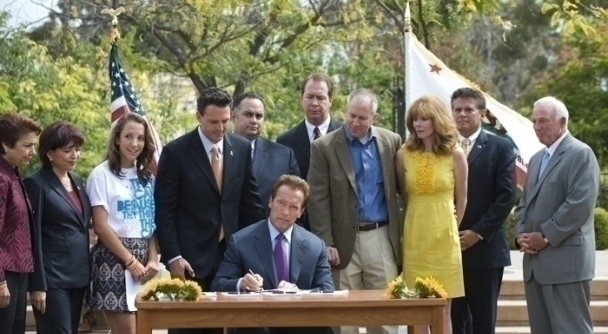Making California Safer

September 24, 2004 Governor Schwarzenegger strengthened Megan’s Law by signing AB 488, which requires the Department of Justice to post specified information regarding high-risk sex offenders on the Internet for public access.
August 16, 2005 Governor Schwarzenegger signed the Sexual Predator Punishment and Control Act (SB 588 and AB 231), which:
• Requires registered sex offenders to wear a global-positioning device for the rest of their lives.
• Establishes Predator Free Zones 2,000 feet from schools and from parks where kids play.
• Increases penalties for the possession of child pornography to a misdemeanor or felony, and automatically makes it a felony for second or more offenses.
• Ensures that sexually violent predators, prior to their parole, stay in a secure hospital until they can prove to a court they no longer pose a danger to society.
• Makes it illegal to lure kids into online relationships with lewd intentions.
• Establishes a sentence enhancement of five years for rapists who use a date-rape drug.
• Eliminates “good time” prison credits for habitual sex offenders.
• Expands parole terms up to ten years for predators who commit the most heinous crimes.
• Expands and strengthens our basic sexual assault punishment statutes, including those for “One-Strike Sex Crimes,” “Habitual Sex Offenders,” and “Aggravated Sexual Assault of a Child.”
September 21, 2005 Governor Schwarzenegger signed AB 22, SB 180, and SB 972, legislation that establishes human trafficking as a crime and increases the severity of punishment for those who commit or benefit from this crime.
September 20, 2006 Governor Schwarzenegger signed a host of laws to protect Californians against Sexual Predators, including:
• SB 1128, which punishes continuous, sexual child abuse with an automatic 25-years-to-life prison sentence; makes possession of pornography depicting children a felony in some cases; discourages plea bargaining for violent sex offenders; and adds youth recreational facilities to the list of places to which convicted sex offenders have restricted access.
• SB 1178, which requires that high-risk sex offenders be fitted with GPS devices and monitored by local law enforcement.
• AB 1015, which creates the Sex Offender Management Board, a high-level task force charged with making immediate recommendations for improving the state’s program to track and monitor paroled sex offenders.
• AB 2263, which requires sex offenders applying for jobs that involve physical contact with children to disclose their registration status to prospective employers.
• AB 1900, which prohibits child sex offenders from employing minors.
November 7, 2006 Proposition 84, also known as Jessica’s Law, was passed at the ballot box with the support of Governor Schwarzenegger. Jessica’s Law strengthens punishments, expands parole periods, and keeps sex offenders away from schools and places where children frequently play.
May 25, 2007 Governor Schwarzenegger established the California Gang Reduction, Intervention, and Prevention Program (CalGRIP), which targets more than $48 million in state and federal funding for local anti-gang efforts, including job training, education and intervention programs, and provision of tools to law enforcement for closely tracking gang leaders both inside and out of state prisons. Additionally, Governor Schwarzenegger appointed a gang czar to head up this statewide anti-gang initiative.
October 17, 2007 Governor Schwarzenegger strengthened DUI laws and increased penalties for underage drinking violations and the manufacturing of fraudulent IDs.
September 24, 2008 Governor Schwarzenegger banned the use of electronic text messaging devices while driving by signing SB 28. This law complemented a 2006 law, SB 1613, which required motorists to use a hands-free device while talking on a mobile phone.
September 30, 2008 Enhancing Megan’s Law, Governor Schwarzenegger signed SB 1187, which added people convicted of felony child pornography to the Megan’s Law online registry.
January 12, 2009 Governor Schwarzenegger carried out a key component of the Sexual Predator Punishment and Control Act by ordering the placement of a GPS device on each of the 6,622 sex offenders on state parole.
August 6, 2009 Governor Schwarzenegger signed legislation giving law enforcement additional resources to monitor and prosecute sex offenders. SB 583 requires the Department of Justice to record the type of residence at which registered sex offenders reside; SB 669 provides that a sexually violent predator’s refusal to participate in treatment may be considered evidence in a jury trial to show that his or her condition has not changed.
October 11, 2009 Governor Schwarzenegger cracked down on DUI offenders by signing AB 91, which created a pilot program in four counties that mandated the installation of an ignition interlock device on every vehicle owned or operated by a first-time DUI offender.
October 11, 2009 Signing AB 17, Governor Schwarzenegger increased the financial penalties on individuals convicted of human trafficking.
October 15, 2009 Building on his commitment to keep dangerous weapons off the streets, Governor Schwarzenegger signed AB 962, which closed an ammunition sales loophole by requiring vendors of handgun ammunition transfers and sales to keep a log of information on handgun ammunition sales, store ammunition in a safe and secure manner, and require face-to-face transfer of ammunition sales.
September 9, 2010 Governor Schwarzenegger signed AB 1844, known as Chelsea’s Law, which enacted a one-strike, life-without-parole sentencing option for the most dangerous sexual offenders; increased sentences for forcible sex crimes; increased parole terms, including lifetime parole, for those who target children under the age of fourteen; restricted sex offenders from entering parks; required that sex offenders’ risk assessment scores be made public through the Megan’s Law website; revised California’s mentally disordered offender laws to provide for continued detention of offenders when evaluation and assessment deem it necessary; and required the state to implement a first-in-the-nation containment model and dynamic risk assessment structure.
